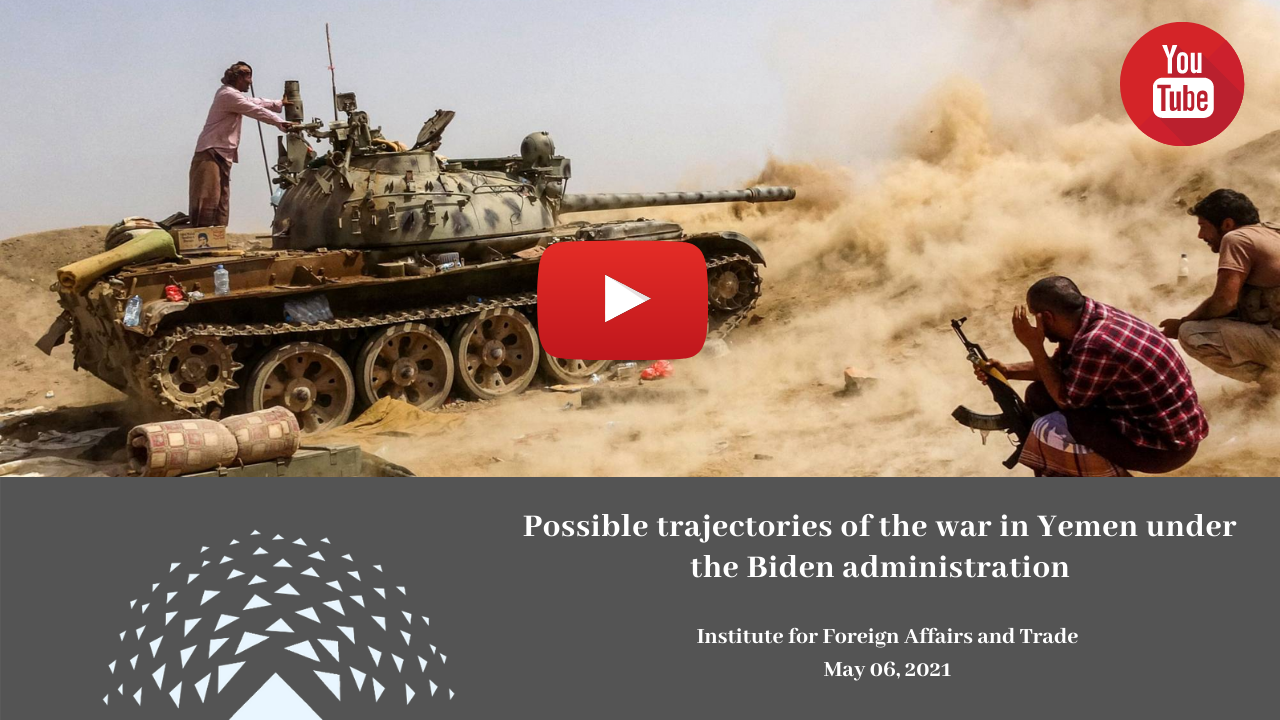On May 6, 2021, the Institute for Foreign Affairs and Trade (IFAT) organized an online roundtable discussion entitled “Possible Trajectories of the War in Yemen under the Biden Administration”. Participants included Júlia Palik, a Senior Researcher at the Peace Research Institute Oslo, and Farea Al-Muslimi, the co-founder of the Sana’a Center for Strategic Studies and an Associate Fellow of Chatham House. The event was moderated by Máté Szalai, Senior Researcher at the Institute for Foreign Affairs and Trade.
In her presentation, Júlia Palik elaborated on the supply-side and the demand-side challenges associated with foreign aid in Yemen. When explaining supply-side challenges, she addressed the inter-connected nature of quantity and quality of aid, the time discrepancies between pledges and actual disbursement, and problems related to accountability and the neutrality of donors. On the demand-side problems, she mentioned Yemen’s historically low capacity of aid absorption, the misuse of development aid and the role of development aid in Yemen’s war economy. She suggested that the US could facilitate the development of institutions that would be able to administer aid. Furthermore, the Biden administration can make steps to lessen Yemen’s aid dependence on GCC states, to help post-war Yemen to develop independent institutions that are more resilient against GCC states political influence.
Farea Al-Muslimi talked about the role of the US in the Yemeni conflict and the expectations of local actors regarding the Biden administration. According to Al-Muslimi, a large part of the United States’ influence in the region was built on perceived and not actual power, something that he believes decreased in the last five years during the Trump administration. Additionally, American foreign policy has been contingent on and influenced by domestic politics and internal struggles. The US – which is not neutral in this conflict – has no policy on Yemen, which Al-Muslimi called problematic. When asked about the ongoing situation on the ground, he stated that if the city of Ma’rib falls into the hands of the Houthis, the country will experience further fragmentation.
Both presenters agreed that it is likely that Yemen (again) becomes a bargaining chip in the US-Iranian negotiations. When asked about the UN’s role, Palik stressed the importance of updating the current Security Council Resolution which was adopted in 2015 and still governs the mediation landscape. Al-Muslimi agreed on the need of a new resolution which does not normalize taking power by force. He stressed that there is no military solution in Yemen, but at the same time the UN will not be able to solve the conflict alone.
In the Q&A session, questions focused on the role of the EU in the Yemeni war, the Houthi movement, and how the COVID-19 pandemic impacted external actors’ capacity and willingness to engage in conflict resolution and reconstruction. According to the speakers, several European states have been active players in the humanitarian funding sector. The EU has a Yemen policy and a dedicated office and has been prominent in funding initiatives, especially when it comes to Track-II mediation, yet in the last few years the EU acted more like a humanitarian aid entity rather than a political actor.
The roundtable discussion concluded with a discussion on the necessary steps leading to the end of the war in Yemen. According to the experts, the first fundamental step would be to agree on a national ceasefire, then to simultaneously adopt a new UN resolution which can guide the peace talks, with the local aspirations considered. Palik and Al-Muslimi agreed that the current situation ofmilitary stalemate is likely to continue. The decision to invest in peace in Yemen needs to be made on all levels.
The full recording can accessed at the link below or on our YouTube-channel!
JTNDaWZyYW1lJTIwd2lkdGglM0QlMjIxMDAlMjUlMjIlMjBoZWlnaHQlM0QlMjI0NTAlMjIlMjBzcmMlM0QlMjJodHRwcyUzQSUyRiUyRnd3dy55b3V0dWJlLmNvbSUyRmVtYmVkJTJGNlAtNUg1eHZuMkklMjIlMjB0aXRsZSUzRCUyMllvdVR1YmUlMjB2aWRlbyUyMHBsYXllciUyMiUyMGZyYW1lYm9yZGVyJTNEJTIyMCUyMiUyMGFsbG93JTNEJTIyYWNjZWxlcm9tZXRlciUzQiUyMGF1dG9wbGF5JTNCJTIwY2xpcGJvYXJkLXdyaXRlJTNCJTIwZW5jcnlwdGVkLW1lZGlhJTNCJTIwZ3lyb3Njb3BlJTNCJTIwcGljdHVyZS1pbi1waWN0dXJlJTIyJTIwYWxsb3dmdWxsc2NyZWVuJTNFJTNDJTJGaWZyYW1lJTNF

